
For aspiring traders looking to work with professional trading firms, understanding what paper trading is a vital first step. Simply put, paper trading is the process of doing simulated trades with respect to real market conditions on the trading day without risking actual money. By this method, traders can develop strategies, perfect risk management, and better build up their confidence before putting in any real cash. For applicants to the best prop firms for futures, paper trading can be an important first step to demonstrate one's talent and be prepared to pass the extraordinary demands often imposed by the firms.
What Is Paper Trading?
Paper trading is, in essence, a method of practicing trading with the use of a simulated account. It allows speculators an opportunity to place trades, track their profits and losses, and learn market dynamics without any monetary exposure. This paper-trading can be simulated on sophisticated trading platforms that closely eclipse the live- market conditions. Traders can test strategies, see new asset classes, and learn market behaviors in a controlled, risk-free environment.
The importance of what is paper trading really lies in its ability to teach discipline and its practice. Emotions, overtrading, bad habits, and poor risk management are common challenges for traders in the early stages of training; these mistakes can be spotted and corrected during paper trading before the applicant turns to trading with real cash. Besides, paper trading is often an accepted requirement for traders targeting the best prop firms for futures. These firms would require candidates to prove, beyond profitability, their willingness to cultivate good trading habits—those very qualities paper trading should instill.
Why Paper Trading is Important for Futures Trading
Futures trading is linked to contracts that require the buying and selling of an asset at the invention's price and date. The leveraging and volatility provided by futures markets justify its title of a high-risk arena, where a mistake may cost large losses. This is where understanding what is paper trading becomes critical, as it provides traders with a place to learn all the nuances of futures contracts without putting capital on the line.
Paper trading can be used for testing one's position sizing, stop loss placement, and different options of entry and exit strategies. This testing teaches you which strategies work in which market conditions, along with developing understanding in market psychology as well as timing, both of which have a great impact upon the success in futures trading. Markets are unforgiving; unaffordable mistakes can be made, which might stop you in your tracks forever.
How Paper Trading is Going to Prepare You for Prop Firm Evaluations
To be accepted into trading with company capital, candidates of many of the best prop firms for futures are usually required to pass an evaluation or challenge. These evaluations usually test for profitability, risk management, and conformity to trading rules for a set period. Paper trading provides the safest and most pertinent way to prepare for these challenges.
Firstly, it helps traders in developing a consistent trading methodology. By tracking trades, analyzing mistakes, and adjusting strategies, applicants can show a disciplined trading pattern very much esteemed by prop firms. Second, paper trading will build its own performance history. Although nothing to show for it in reality, having an actual paper journal to go through, and show successful trades and adjustments in strategy gives the trader conferences and conviction to take a proper evaluation. Last, paper trading stress-tests traders and their strategies. Traders can create and face different market conditions, whether high-volatility ones or trending markets, so they are fully equipped to work in real world situations.
Choosing the Right Platforms on Which to Conduct Paper Trading
Selecting your paper trading platforms wisely is vital for the success of your paper trading. The current market offers dozens of trading platforms ranging from brokers that operate demo accounts accurately reproducing futures markets. While practicing, traders should strive to replicate actual trading conditions with regards to account size, leverage, and realistic risk limits. Practicing under such conditions would certainly hone their skill, thus giving them more confidence and comfort when transitioning to the real evaluation of their chosen prop firm.
Conclusion
Knowing what is paper trading and using it wisely is perhaps the most important step for anybody once intending to join the best prop firms for futures. Paper trading creates a risk-free environment in which a lot of strategies can be practiced, thereby developing discipline, boosting self-confidence, and providing a solid foundation for making money in the world of futures trading. Paper trading will aid in avoiding potentially costly mistakes while equipping traders with sufficient tools and experience to maneuver through prop firm evaluations with relative ease. For the trader wishing to embark on a professional path, being able to embrace paper trading is not merely an airport for a learning exercise, but a strategic path toward achieving a wider trading success in future.
